Ultimate Strength Behaviour and Optimization of Laser-Welded Web-Core Sandwich Panels under In-Plane Compression
Abstract
:1. Introduction
2. Case Study
| [8–12 mm] with increment of 2 mm. |
| [6–12 mm] with increment of 2 mm. |
| [100–200 mm] with increment of 50 mm. |
| [100–400 mm] with increment of 100 mm. |
3. Finite Element Modelling
3.1. Numerical Model Characteristics
3.2. Boundary Conditions and Loading
3.3. Initial Imperfections
- Local deflection of the sandwich plate:
- Symmetric local deflections of the face plates;
- Asymmetric local deflections of the face plates.
- Global deflection of the sandwich plate.
3.4. Validation of the Applied Procedure
3.5. NLFEA Results for Sandwich Panels
4. Optimization Analysis and Results
5. Conclusions
Author Contributions
Funding
Institutional Review Board Statement
Informed Consent Statement
Data Availability Statement
Conflicts of Interest
References
- D’Alessandro, V.; Amabili, M.; De Rosa, S.; Franco, F. Preliminary identifications of sandwich panels. In Proceedings of the INTER-NOISE and NOISE-CON Congress and Conference Proceedings, New York, NY, USA, 19–22 August 2012; Institute of Noise Control Engineering: Washington, DC, USA, 2012; pp. 188–197. [Google Scholar]
- Ramnath, B.V.; Alagarraja, K.; Elanchezhian, C. Review on sandwich composite and their applications. Mater. Today Proc. 2019, 16, 859–864. [Google Scholar] [CrossRef]
- Elsaka, M.; Soares, C.G. Review of the structural configuration and strength of metallic sandwich panels. In Advances in the Analysis and Design of Marine Structures; CRC Press: Boca Raton, FL, USA, 2023; pp. 837–847. [Google Scholar]
- Zenkert, D. The Handbook of Sandwich Construction; Engineering Materials Advisory Services: Solihull, UK, 1997. [Google Scholar]
- Carlsson, L.A.; Kardomateas, G.A. Structural and Failure Mechanics of Sandwich Composites; Springer Science & Business Media: Berlin, Germany, 2011; Volume 121. [Google Scholar]
- Gopichand, A.; Krishnaiah, G.; Reddy, D.; SHANKAR, V. Modal Analysis of a Steel Sandwich Plate System (SPS) Floor. Int. J. Eng. Res. Technol. 2013, 2, 3002–3004. [Google Scholar]
- Kujala, P.; Romanoff, J.; Salminen, A.; Varis, J.; Vilpas, M. All Steel Sandwich Panels; Finnish Federation of Metallic Industry, MET: Helsinki, Finland, 2003. [Google Scholar]
- Kujala, P.; Klanac, A. Steel sandwich panels in marine applications. Brodogr.Teor. Praksa Brodogr. Pomor. Teh. 2005, 56, 305–314. [Google Scholar]
- SANDCORe. Best Practice Guide for Sandwich Structures in Marine Applications; European Commission Contract No. FP6-506330; SANDCORe: Hamburg, Germany, 2013. [Google Scholar]
- Mantari, J.; Guedes Soares, C. Generalized layerwise HSDT and finite element formulation for symmetric laminated and sandwich composite plates. Compos. Struct. 2013, 105, 319–331. [Google Scholar] [CrossRef]
- Barsotti, B.; Gaiotti, M.; Rizzo, C.M. Recent industrial developments of marine composites limit states and design approaches on strength. J. Mar. Sci. Appl. 2020, 19, 553–566. [Google Scholar] [CrossRef]
- Chen, N.-Z.; Guedes Soares, C. Ultimate longitudinal strength of ship hulls of composite materials. J. Ship Res. 2008, 52, 184–193. [Google Scholar] [CrossRef]
- Cao, J.; Grenestedt, J.L. Design and testing of joints for composite sandwich/steel hybrid ship hulls. Compos. Part A Appl. Sci. Manuf. 2004, 35, 1091–1105. [Google Scholar] [CrossRef]
- Kharghani, N.; Guedes Soares, C. Experimental and numerical study of hybrid steel-FRP balcony overhang of ships under shear and bending. Mar. Struct. 2018, 60, 15–33. [Google Scholar] [CrossRef]
- Metschkow, B. Sandwich panels in shipbuilding. Pol. Marit. Res. 2006, 13, 5–8. [Google Scholar]
- Kozak, J. Selected problems on application of steel sandwich panels to marine structures. Pol. Marit. Res. 2009, 16, 9–15. [Google Scholar] [CrossRef]
- Elsaka, M.; Leheta, H.; Zayed, A.; Badran, S. Strength and weight characteristics of a self-propelled barge based on sandwich panel system construction. In Sustainable Development and Innovations in Marine Technologies, Proceedings of the 18th International Congress of the Maritme Association of the Mediterranean (IMAM 2019), Varna, Bulgaria, 9–11 September 2019; CRC Press: Boca Raton, FL, USA, 2019; p. 403. [Google Scholar]
- Boroński, D.; Szala, J. Fatigue life tests of steel laser-welded sandwich structures. Pol. Marit. Res. 2006, 13, 27–30. [Google Scholar]
- Konka, K.; Rao, J.; Gupta, K.S.A. Heat insulation analysis of an aluminum honeycomb sandwich structure. J. Therm. Eng. 2014, 1, 210–220. [Google Scholar] [CrossRef]
- Crupi, V.; Epasto, G.; Guglielmino, E. Collapse modes in aluminium honeycomb sandwich panels under bending and impact loading. Int. J. Impact Eng. 2012, 43, 6–15. [Google Scholar] [CrossRef]
- Cheng, Y.; Liu, M.; Zhang, P.; Xiao, W.; Zhang, C.; Liu, J.; Hou, H. The effects of foam filling on the dynamic response of metallic corrugated core sandwich panel under air blast loading–Experimental investigations. Int. J. Mech. Sci. 2018, 145, 378–388. [Google Scholar] [CrossRef]
- Brooking, M. The performance, safety and production benefits of SPS structures for double hull tankers. In Proceedings of the RINA Conference on Double Hull Tankers in London, London, UK, 25–26 February 2004. [Google Scholar]
- Kozak, J. Problems of strength modelling of steel sandwich panels under in-plane load. Pol. Marit. Res. 2006, 13, 9–12. [Google Scholar]
- Kolsters, H.; Zenkert, D. Buckling of laser-welded sandwich panels: Ultimate strength and experiments. Proc. Inst. Mech. Eng. Part M J. Eng. Marit. Environ. 2010, 224, 29–45. [Google Scholar] [CrossRef]
- Jelovica, J.; Romanoff, J. Comparison of load-carrying behavior between web-core sandwich, stiffened and isotropic plate. In Tree Biotechnology; CRC Press: Boca Raton, FL, USA, 2014; p. 397. [Google Scholar]
- Jelovica, J.; Romanoff, J. Buckling of sandwich panels with transversely flexible core: Correction of the equivalent single-layer model using thick-faces effect. J. Sandw. Struct. Mater. 2020, 22, 1612–1634. [Google Scholar] [CrossRef]
- Li, Z.; Huang, L.; Zhao, N.; Liu, J.; Hu, J.; Qi, E. Ultimate bearing capacity for steel sandwich panels under uniaxial compression. Chin. Ship Res. 2020, 15, 53–58. (In Chinese) [Google Scholar]
- Zhong, Q.; Wang, D. Ultimate strength behavior of laser-welded web-core sandwich plates under in-plane compression. Ocean Eng. 2021, 238, 109685. [Google Scholar] [CrossRef]
- Zhong, Q.; Wu, G.; Han, Z.; Wang, D. Comparative investigation on ultimate strength of hull girder with laser-welded web-core sandwich deck. Ocean Eng. 2022, 264, 112483. [Google Scholar] [CrossRef]
- Tekgoz, M.; Garbatov, Y.; Soares, C.G. Finite element modelling of the ultimate strength of stiffened plates with residual stresses. In Analysis Design of Marine Structures; Taylor & Francis Group: Abingdon, UK, 2014; pp. 309–317. [Google Scholar]
- Paik, J.K.; Mansour, A.E. A simple formulation for predicting the ultimate strength of ships. J. Mar. Sci. Technol. 1995, 1, 52–62. [Google Scholar] [CrossRef]
- Gordo, J.; Soares, C.G.; Faulkner, D. Approximate assessment of the ultimate longitudinal strength of the hull girder. J. Ship Res. 1996, 40, 60–69. [Google Scholar] [CrossRef]
- Gordo, J.; Soares, C.G. Tests on ultimate strength of hull box girders made of high tensile steel. Mar. Struct. 2009, 22, 770–790. [Google Scholar] [CrossRef]
- Leheta, H.W.; Elhanafi, A.S.; Badran, S.F. A numerical study of the ultimate strength of Y-deck panels under longitudinal in-plane compression. Thin-Walled Struct. 2016, 100, 134–146. [Google Scholar] [CrossRef]
- Xu, M.C.; Yanagihara, D.; Fujikubo, M.; Soares, C.G. Influence of boundary conditions on the collapse behaviour of stiffened panels under combined loads. Mar. Struct. 2013, 34, 205–225. [Google Scholar] [CrossRef]
- Tekgoz, M.; Garbatov, Y.; Soares, C.G. Ultimate strength assessment of welded stiffened plates. Eng. Struct. 2015, 84, 325–339. [Google Scholar] [CrossRef]
- Chen, B.-Q.; Guedes Soares, C. A simplified model for the effect of weld-induced residual stresses on the axial ultimate strength of stiffened plates. J. Mar. Sci. Appl. 2018, 17, 57–67. [Google Scholar] [CrossRef]
- Ueda, Y.; Rashed, S.; Paik, J. Buckling and ultimate strength interaction in plates and stiffened panels under combined inplane biaxial and shearing forces. Mar. Struct. 1995, 8, 1–36. [Google Scholar] [CrossRef]
- Paik, J.K.; Seo, J.K. Nonlinear finite element method models for ultimate strength analysis of steel stiffened-plate structures under combined biaxial compression and lateral pressure actions—Part I: Plate elements. Thin-Walled Struct. 2009, 47, 1008–1017. [Google Scholar] [CrossRef]
- Saad-Eldeen, S.; Garbatov, Y.; Soares, C.G. Analysis of plate deflections during ultimate strength experiments of corroded box girders. Thin-Walled Struct. 2012, 54, 164–176. [Google Scholar] [CrossRef]
- Chen, B.-Q.; Guedes Soares, C. Effects of plate configurations on the weld induced deformations and strength of fillet-welded plates. Mar. Struct. 2016, 50, 243–259. [Google Scholar] [CrossRef]
- Jelovica, J.; Romanoff, J. Load-carrying behaviour of web-core sandwich plates in compression. Thin-Walled Struct. 2013, 73, 264–272. [Google Scholar] [CrossRef]
- Ozguc, O.; Das, P.; Barltrop, N. A proposed method to evaluate hull girder ultimate strength. Ships Offshore Struct. 2006, 1, 335–345. [Google Scholar] [CrossRef]
- Du, J.; Yang, P.; Cui, C.; Xia, T. Ultimate strength of steel panels and stiffened plates with longitudinal through-thickness cracks under compression. In Proceedings of the 4th International Conference on Sustainable Energy and Environmental Engineering, Shenzhen, China, 20–21 December 2015; Atlantis Press: Dordrecht, The Netherlands, 2016; pp. 837–843. [Google Scholar]
- Khan, I.; Zhang, S. Effects of welding-induced residual stress on ultimate strength of plates and stiffened panels. Ships Offshore Struct. 2011, 6, 297–309. [Google Scholar] [CrossRef]
- Baş, D.; Boyacı, I.H. Modeling and optimization I: Usability of response surface methodology. J. Food Eng. 2007, 78, 836–845. [Google Scholar] [CrossRef]
- Grebenişan, G.; Salem, N. The multi-objective genetic algorithm optimization, of a superplastic forming process, using ansys®. In Proceedings of the MATEC Web of Conferences, Sibiu, Romania, 7–9 June 2017; EDP Sciences: Les Ulis, France, 2017; p. 03003. [Google Scholar]
- Verma, S.; Pant, M.; Snasel, V. A comprehensive review on NSGA-II for multi-objective combinatorial optimization problems. IEEE Access 2021, 9, 57757–57791. [Google Scholar] [CrossRef]
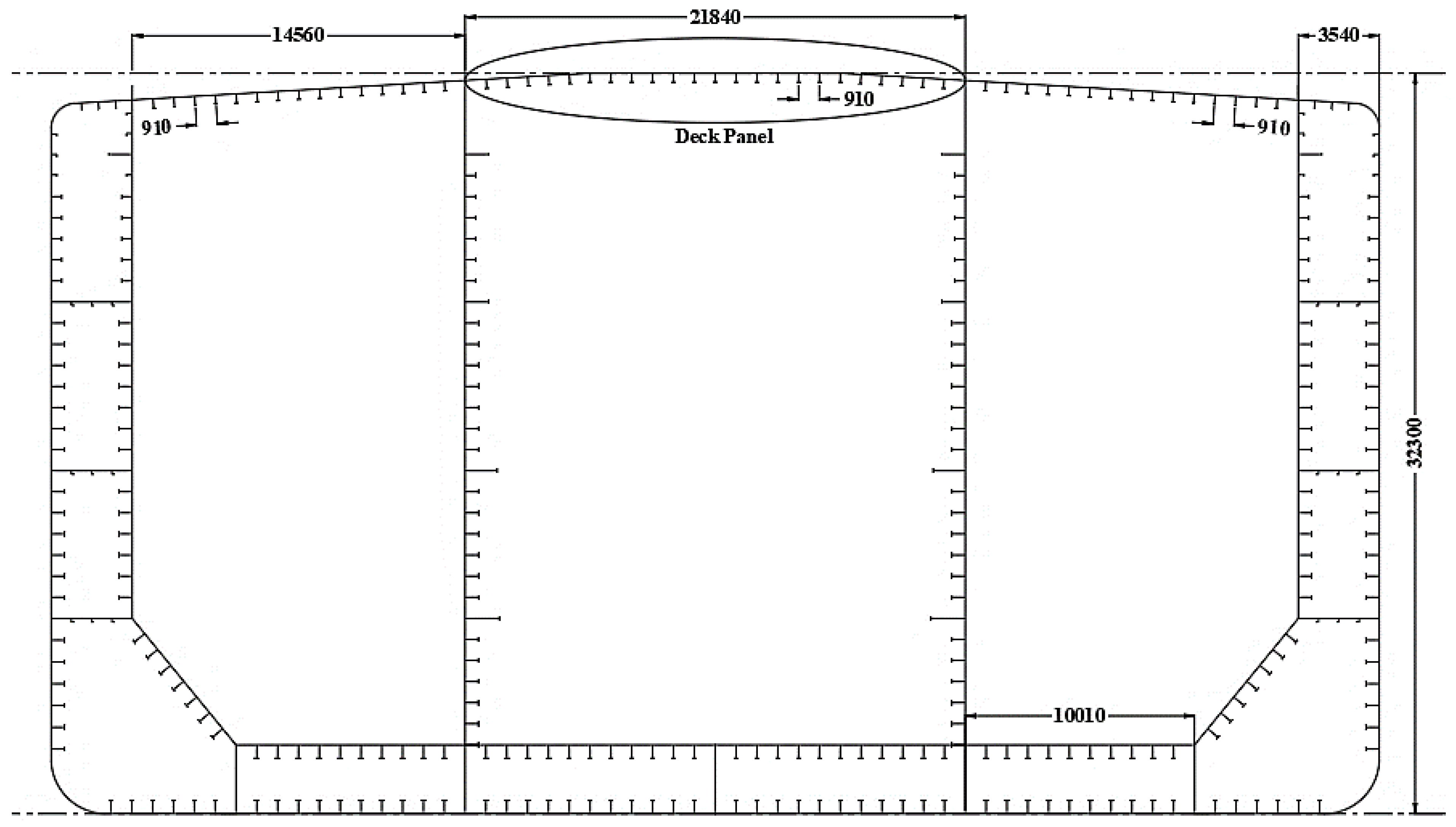
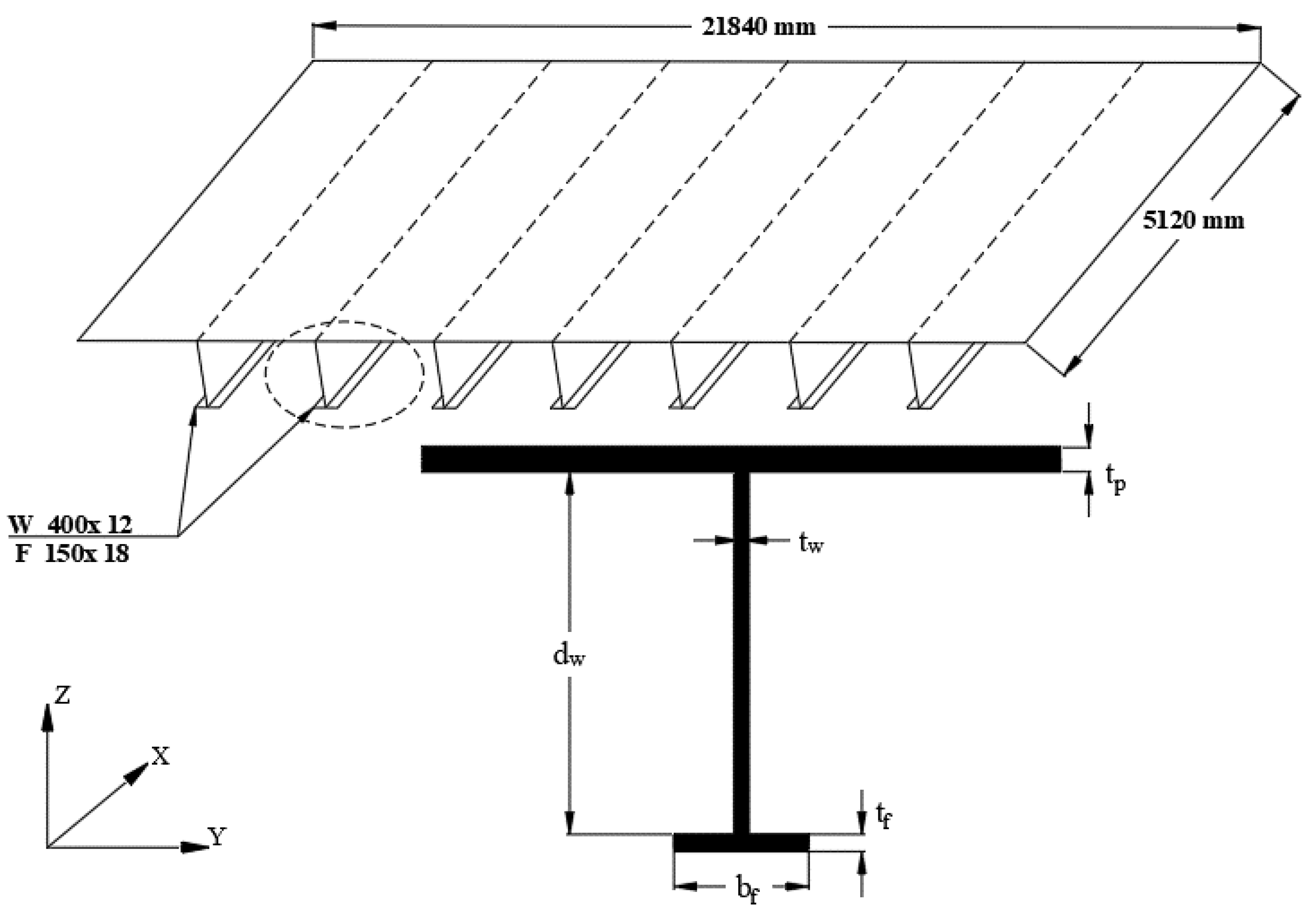

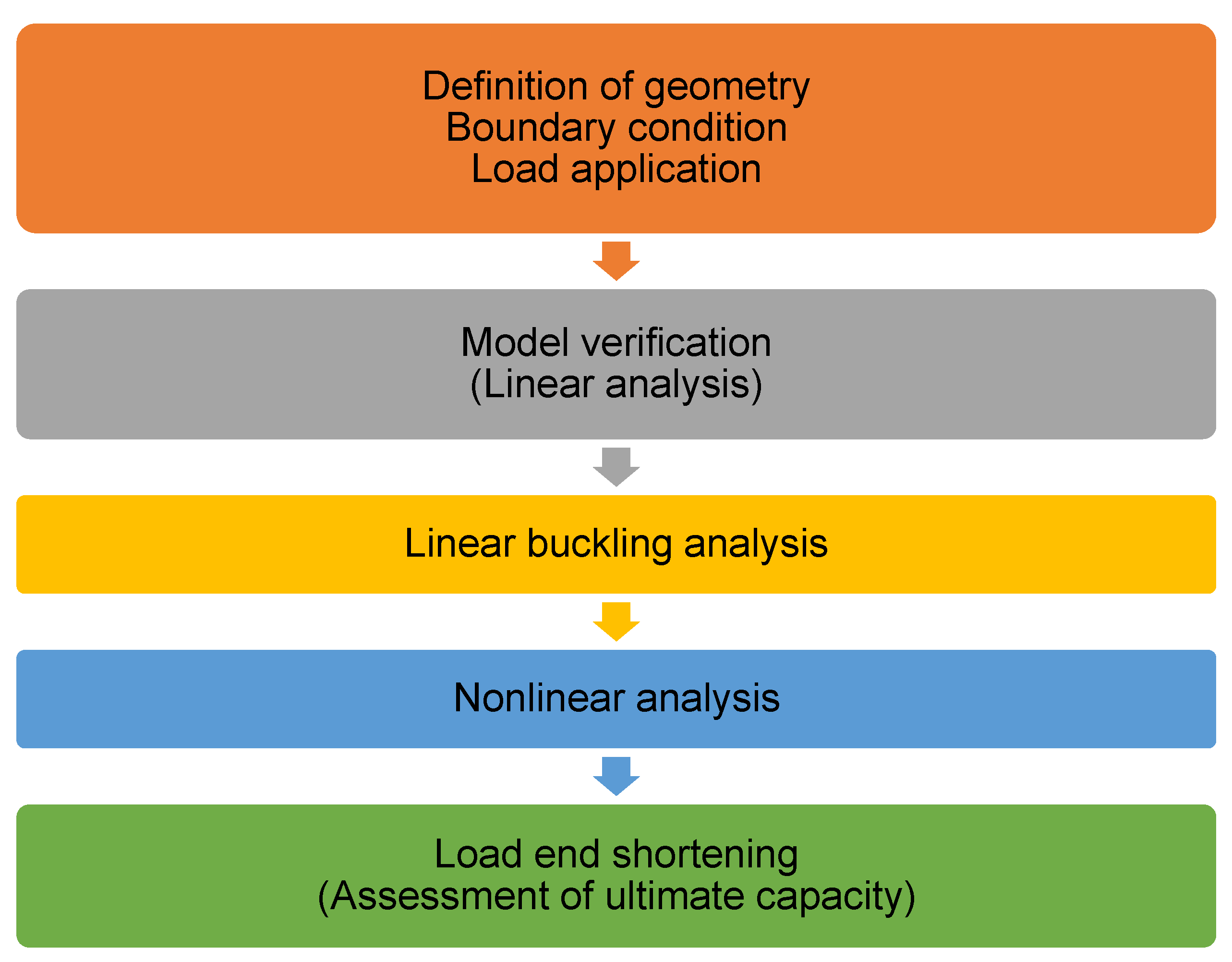


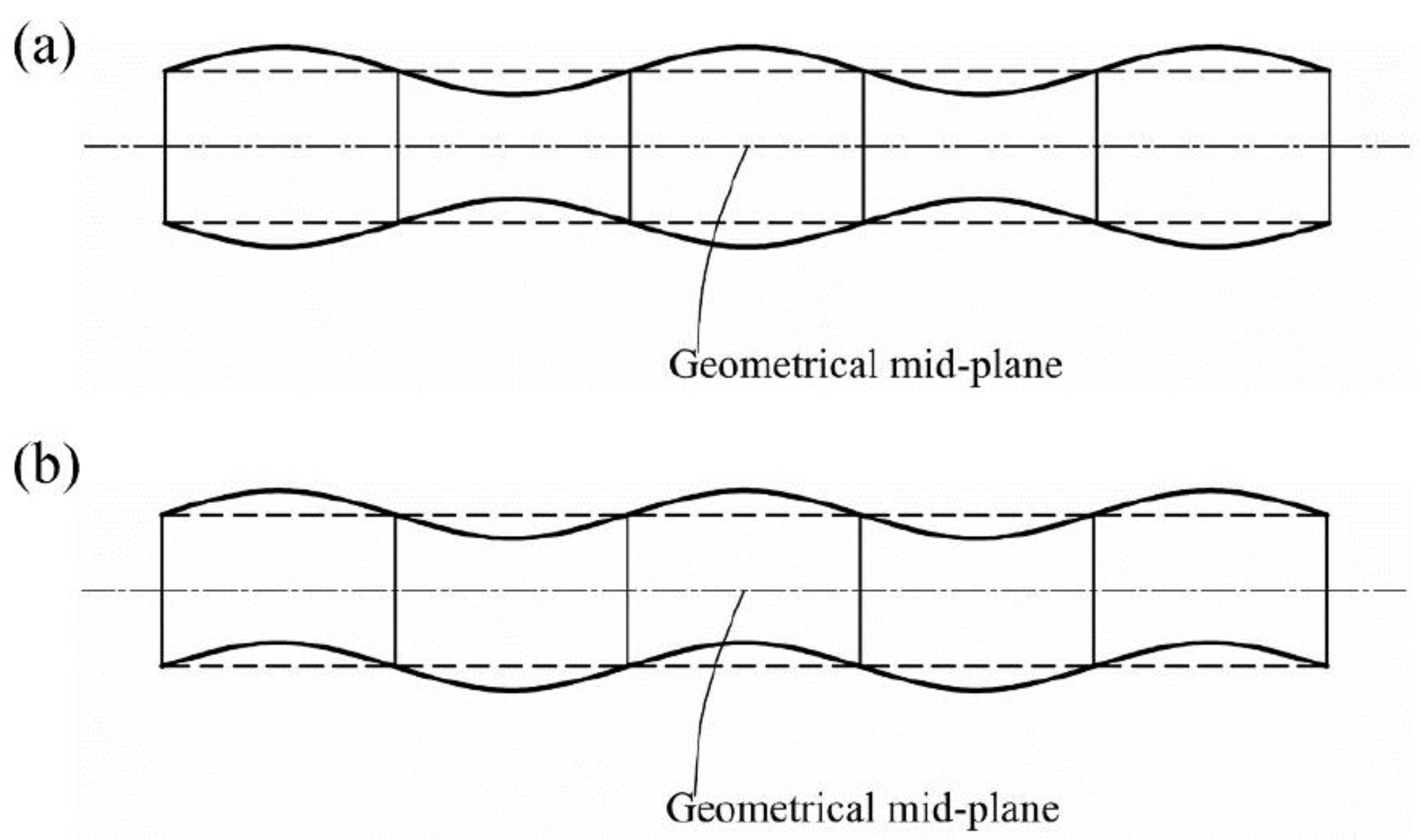



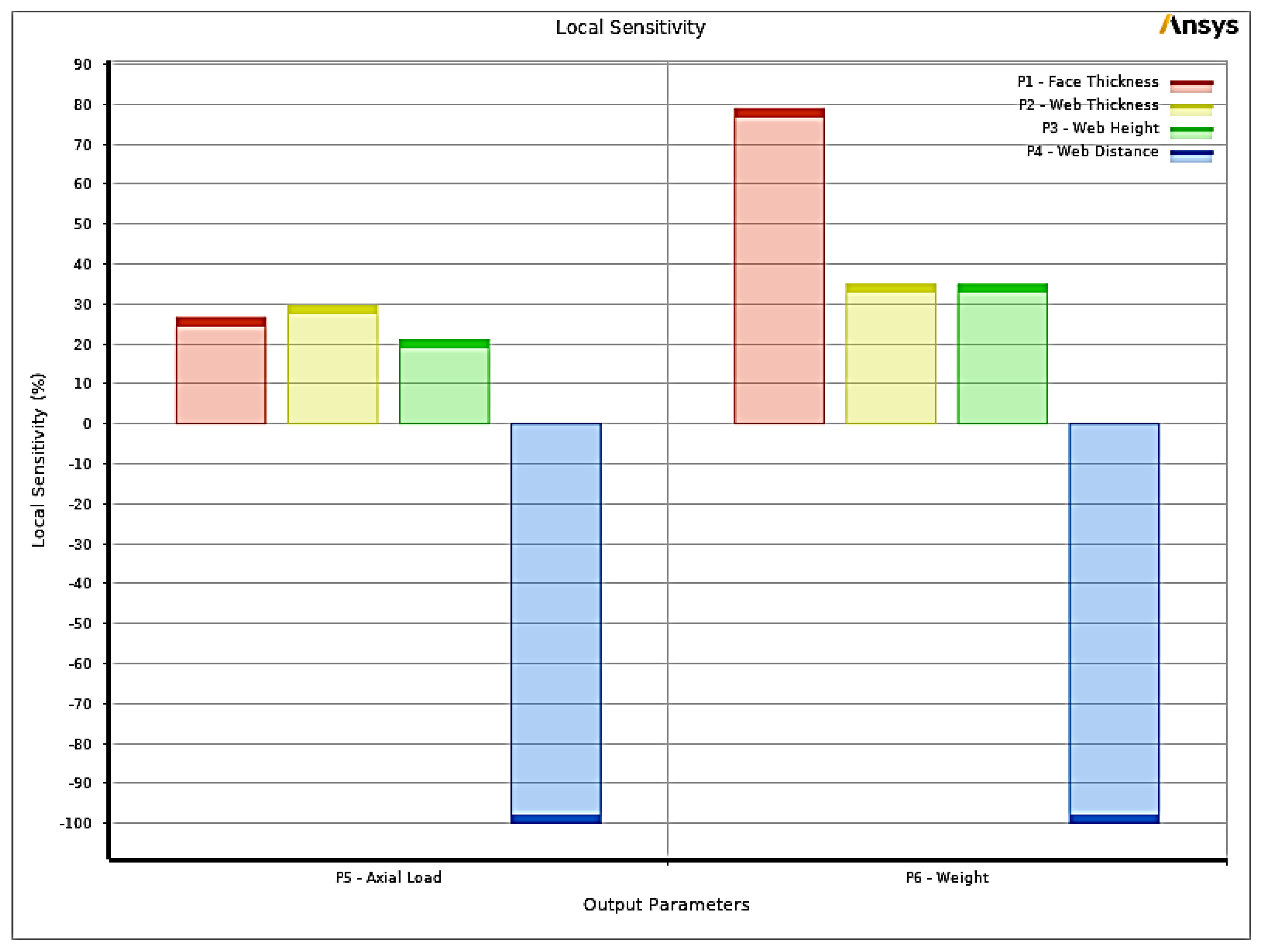
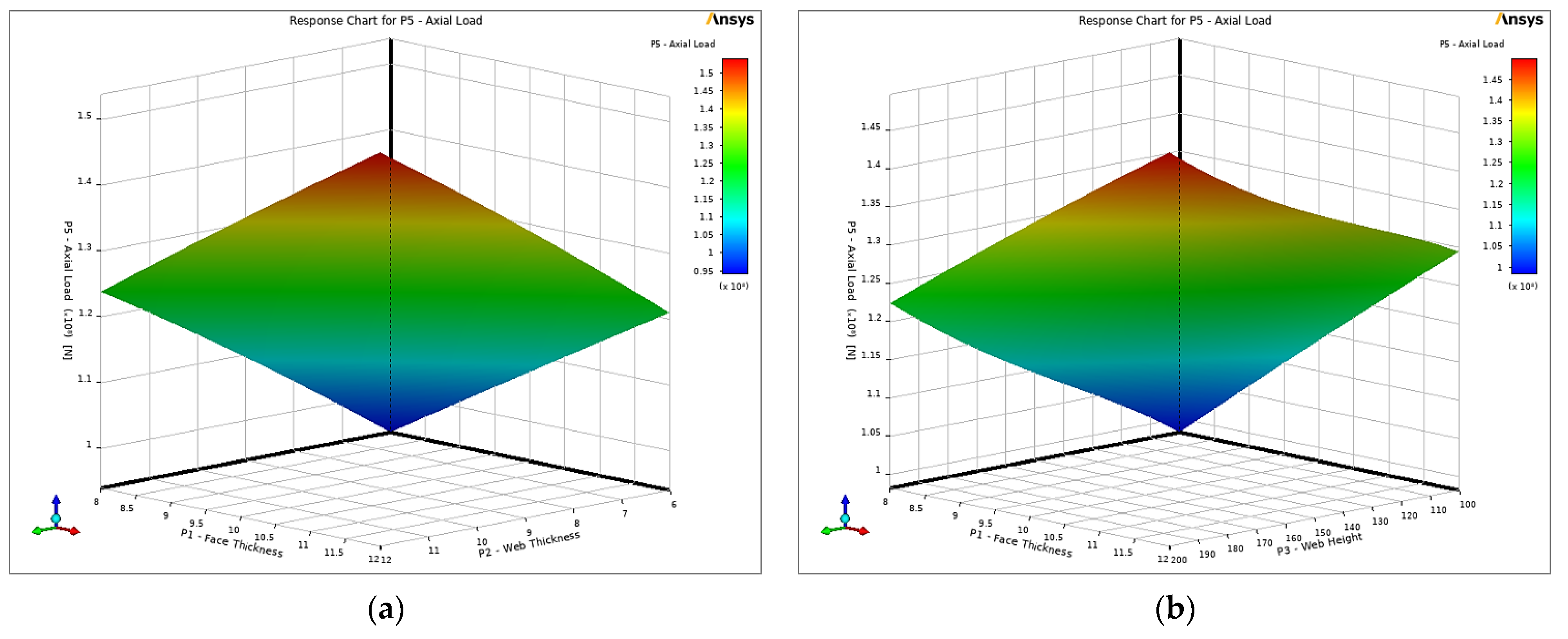

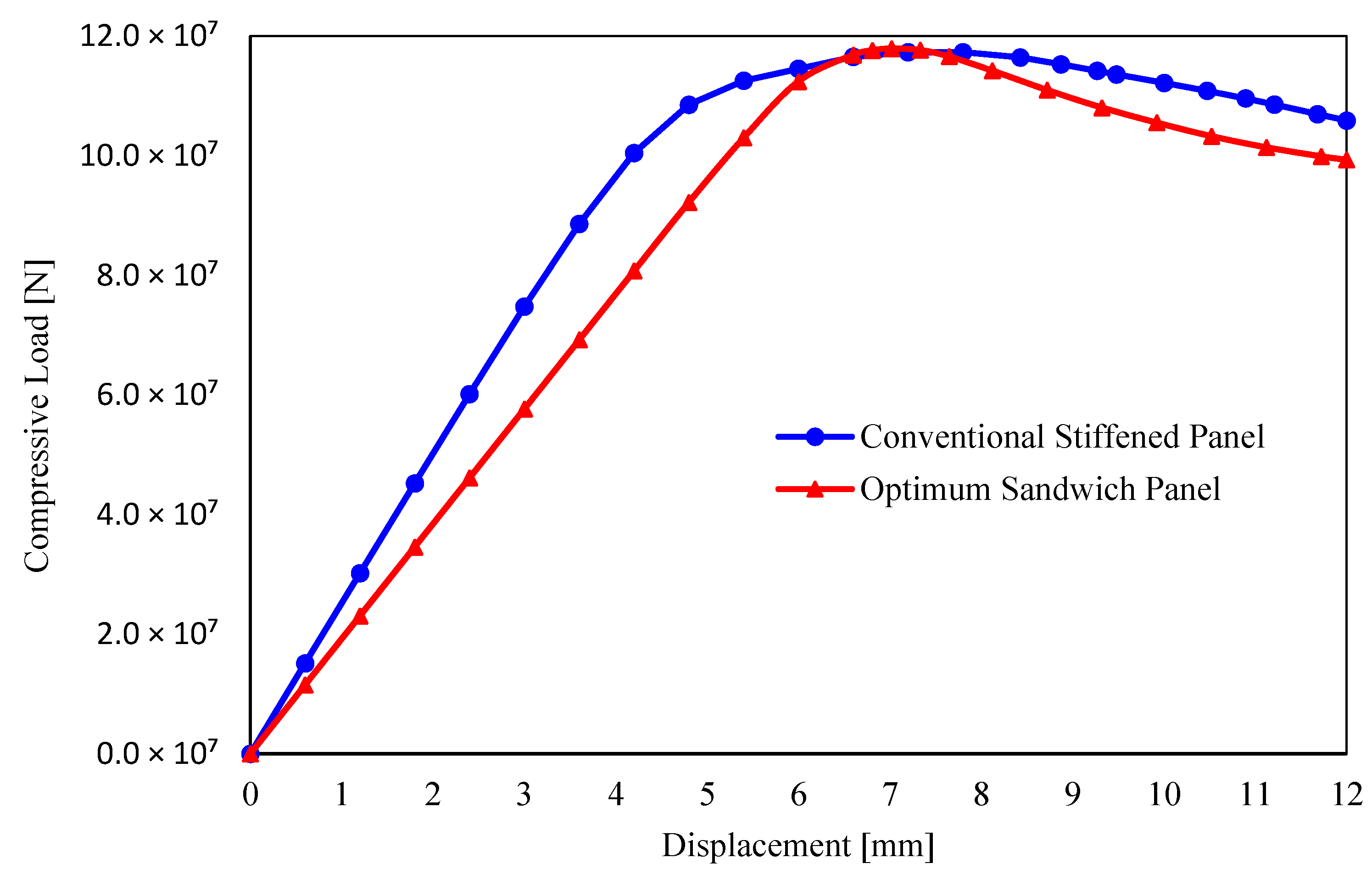
| Parameter | Value |
|---|---|
| Ship length overall (m) | 332 |
| Ship length between perpendicular (m) | 320 |
| Ship breadth (m) | 58 |
| Ship depth (m) | 31 |
| Design draft (m) | 20.8 |
| Displacement at design draft (ton) | 341,000 |
| Density | Young’s Modulus | Poisson’s Ratio | Yield Stress | Strain Hardening |
|---|---|---|---|---|
| kg/m3 | E (MPa) | ν | σy (MPa) | Et/E |
| 7800 | 206,000 | 0.3 | 315 | 0 |
| L (mm) | Bp (mm) | s (mm) | N | tp (mm) | dw (mm) | tw (mm) | bf (mm) | tf (mm) |
|---|---|---|---|---|---|---|---|---|
| 4300 | 4075 | 815 | 4 | 17 | 463 | 8 | 172 | 17 |
| Input Parameters | Output Parameters | |||||
|---|---|---|---|---|---|---|
| tf (mm) | tw (mm) | hc (mm) | S (mm) | Ultimate Load (N) | Weight (ton) | |
| Candidate Point 1 | 8.0321 | 7.9796 | 100.88 | 177.61 | 1.18 × 108 | 18.092 |
| Candidate Point 2 | 8.0686 | 7.5898 | 102.48 | 174.91 | 1.18 × 108 | 18.089 |
| Candidate Point 3 | 8.0171 | 7.273 | 108.69 | 174.21 | 1.18 × 108 | 18.1 |
Disclaimer/Publisher’s Note: The statements, opinions and data contained in all publications are solely those of the individual author(s) and contributor(s) and not of MDPI and/or the editor(s). MDPI and/or the editor(s) disclaim responsibility for any injury to people or property resulting from any ideas, methods, instructions or products referred to in the content. |
© 2023 by the authors. Licensee MDPI, Basel, Switzerland. This article is an open access article distributed under the terms and conditions of the Creative Commons Attribution (CC BY) license (https://creativecommons.org/licenses/by/4.0/).
Share and Cite
Elsaka, M.; Guedes Soares, C. Ultimate Strength Behaviour and Optimization of Laser-Welded Web-Core Sandwich Panels under In-Plane Compression. J. Mar. Sci. Eng. 2023, 11, 2200. https://doi.org/10.3390/jmse11112200
Elsaka M, Guedes Soares C. Ultimate Strength Behaviour and Optimization of Laser-Welded Web-Core Sandwich Panels under In-Plane Compression. Journal of Marine Science and Engineering. 2023; 11(11):2200. https://doi.org/10.3390/jmse11112200
Chicago/Turabian StyleElsaka, Mohamed, and C. Guedes Soares. 2023. "Ultimate Strength Behaviour and Optimization of Laser-Welded Web-Core Sandwich Panels under In-Plane Compression" Journal of Marine Science and Engineering 11, no. 11: 2200. https://doi.org/10.3390/jmse11112200






